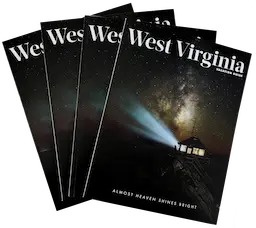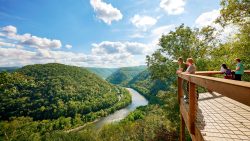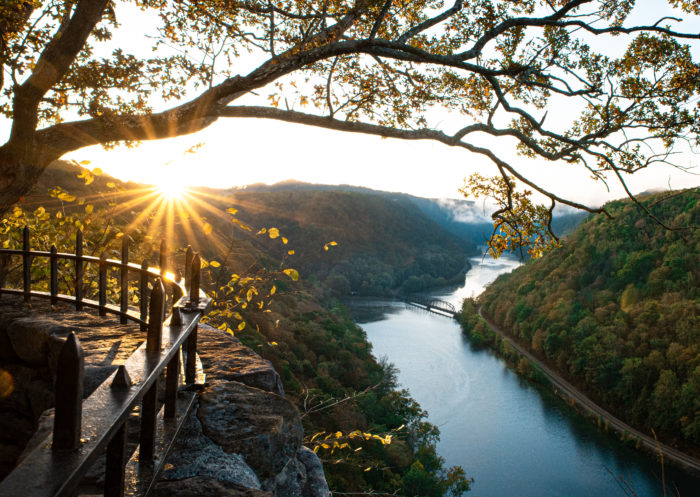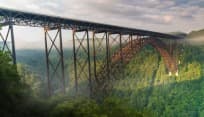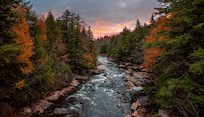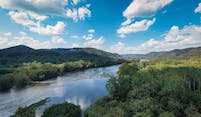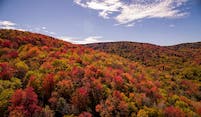Tall tales: John Henry & other folk legends
West Virginia’s hills have spawned dozens of colorful characters who went on to become immortalized in books, songs, movies and television. How many of these folk legends do you know?
1. John Henry
The story of John Henry’s epic battle against the machine is immortalized in the popular folk song “The Ballad of John Henry.” As the legend goes, John Henry was a steel-driving man, tasked with hammering a steel drill into rock to make holes where the workers would plant explosives to construct a mile-long railroad tunnel.
When the company bought a steam-powered drill to do the job, John Henry vowed to defeat the drill or die trying. He won the race, only to collapse and die from exhaustion afterwards.
Historians have concluded that a real John Henry did exist; he was one of the thousands of African-American laborers who worked from 1870 to 1873 to build the Big Bend Tunnel on the Chesapeake and Ohio railway line.
At the tunnel’s entrance in Talcott, you’ll find a life-sized statue of John Henry wielding the sledgehammer that won him the battle against the machine. Every July the community of Talcott honors his legacy during the John Henry Days festival.
2. Mary Draper Ingles
In 1775, during the French and Indian War, a Shawnee war party invaded the Virginia farming settlement of Draper’s Meadow, killing several settlers and capturing others. Mary Draper Ingles and her 2 young sons were among the captives.
They were forced to march to the Shawnees’ home villages near present-day Chillicothe, Ohio. The captors took Mary’s children from her and gave her to a French trader.
Mary and another woman eventually escaped. Without supplies or a map, they followed the Ohio, Kanawha and New rivers 500 miles eastward until they returned to Draper’s Meadow, where Mary was reunited with her husband and eventually one of her sons.
You can read about the women’s harrowing journey in the James Alexander Thom novel “Follow the River” or walk in their footsteps on trails established by the Mary Ingles Trail Blazers in Kanawha State Forest, the New River Gorge or on the AEP conservation tract in Putnam County.
3. Johnny Appleseed
West Virginia’s 2 native apple varieties can be traced back to American pioneer John Chapman– better known as the folk hero Johnny Appleseed.
After apprenticing under an orchardist in the mid-1700s, the young man traveled through several states, including present-day West Virginia, planting nurseries. His reputation as a conservationist earned him a place in history, and as the subject of many books and films.
The 2 varieties Johnny Appleseed planted in the Mountain State were the Grimes Golden and West Virginia’s state fruit, the Golden Delicious, which is probably an offspring of the Grimes Golden.
Celebrate this tasty fruit every fall at the Clay County Golden Delicious Festival.
4. Daniel Boone
Frontiersman Daniel Boone reached folk hero status through his adventures.
Born in 1734 in Pennsylvania, he grew up among (and dressed like) the Delaware Indians. He served in the French and Indian War and the Revolutionary War, earning a reputation as one of the best sharpshooters around. He is probably best known for his explorations, which included his discovery of the Cumberland Gap, a narrow passage through the Appalachian Mountains in Kentucky.
Daniel Boone lived near present-day Charleston for a while, where he represented Kanawha County in the Virginia General Assembly. Several landmarks in the area bear his name, including Daniel Boone Park in Charleston and Boone County.
5. Belle Boyd
Maria Isabella “Belle” Boyd was one of the Civil War’s most notorious spies. Born in 1844 in Martinsburg in present-day West Virginia, she started spying for the Confederacy as a teenager.
Because she was so young, she could pass unnoticed through Union-occupied Martinsburg as she transported information and supplies to southern troops. Despite several arrests and jail time, she doggedly continued her work for the south, earning nicknames like La Belle Rebelle.
In 1864 as she was attempting to transport Confederate papers to England, she was again arrested as a spy. This time she fell in love with one of her Union captors, and the 2 married and had a daughter. After penning her memoirs, “Belle Boyd in Camp and Prison,” she settled into a career as an actress, eventually marrying a 2nd and 3rd time. (Ironically, her second husband also was a Union officer.)
You can learn about her colorful history at the Belle Boyd House and Civil War Museum in Martinsburg.
6. Devil Anse Hatfield
William Anderson “Devil Anse” Hatfield of West Virginia led the infamous feud against the McCoy clan of Kentucky.
Born in 1839 in present-day Logan, Devil Anse was a Confederate Army veteran and a founding member of the Logan Wildcats, a Confederate guerrilla fighting unit.
The Hatfield and McCoy feud started in 1865 when Asa Harmon McCoy, Union soldier and younger brother of McCoy patriarch Randolph McCoy, was murdered by the Logan Wildcats on his way home from the war. The feud continued for nearly 3 decades, involving a stolen pig, bootlegging, arson, an illicit love affair and several more murders.
Stop by the Tug Valley Chamber of Commerce in Williamson and pick up a driving guide to feud sites, which include the Hatfield Family Cemetery. Devil Anse’s grave is marked with a life-sized marble sculpture imported from Italy.
This post was last updated on October 18, 2017
